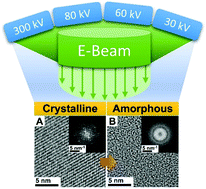Two-dimensional polymeric graphitic carbon nitride (g-C3N4) is a low-cost material with versatile properties that can be enhanced by the introduction of dopant atoms and by changing the degree of polymerization/stoichiometry, which offers significant benefits for numerous applications. Herein, we investigate the stability of g-C3N4 under electron beam irradiation inside a transmission electron microscope operating at different electron acceleration voltages. Our findings indicate that the degradation of g-C3N4 occurs with N species preferentially removed over C species. However, the precise nitrogen group from which N is removed from g-C3N4 (C–N–C, ![[double bond, length as m-dash]](http://www.rsc.org/images/entities/char_e001.gif) NH or –NH2) is unclear. Moreover, the rate of degradation increases with decreasing electron acceleration voltage, suggesting that inelastic scattering events (radiolysis) dominate over elastic events (knock-on damage). The rate of degradation by removing N atoms is also sensitive to the current density. Hence, we demonstrate that both the electron acceleration voltage and the current density are parameters with which one can use to control the stoichiometry. Moreover, as N species were preferentially removed, the d-spacing of the carbon nitride structure increased. These findings provide a deeper understanding of g-C3N4.
NH or –NH2) is unclear. Moreover, the rate of degradation increases with decreasing electron acceleration voltage, suggesting that inelastic scattering events (radiolysis) dominate over elastic events (knock-on damage). The rate of degradation by removing N atoms is also sensitive to the current density. Hence, we demonstrate that both the electron acceleration voltage and the current density are parameters with which one can use to control the stoichiometry. Moreover, as N species were preferentially removed, the d-spacing of the carbon nitride structure increased. These findings provide a deeper understanding of g-C3N4.

